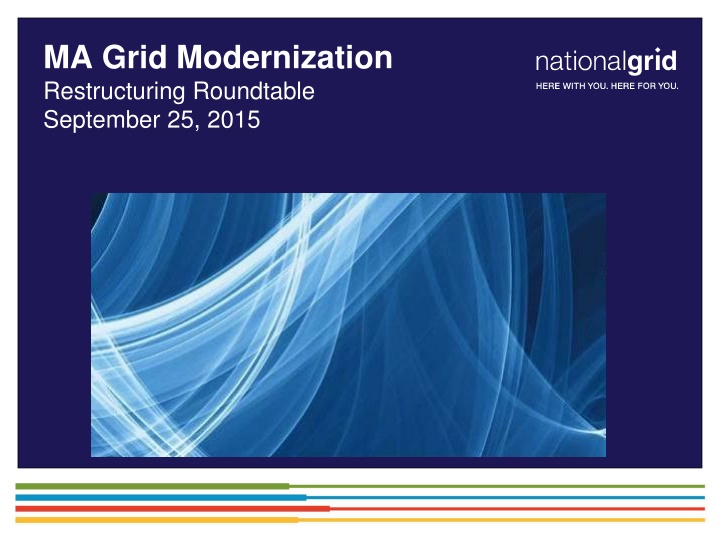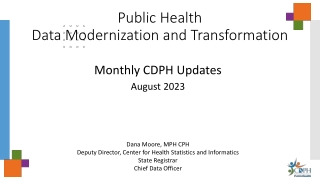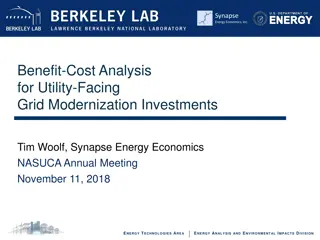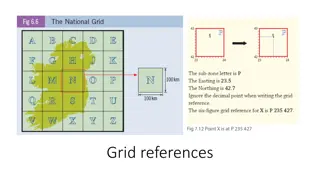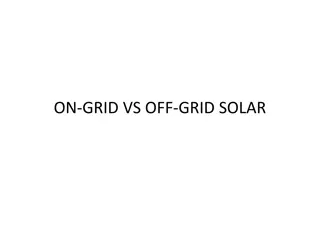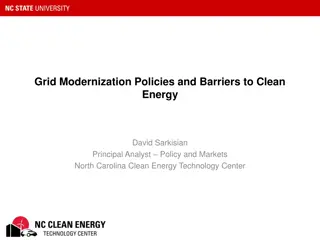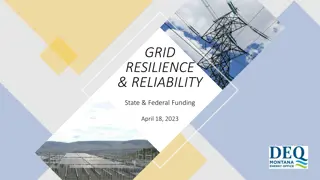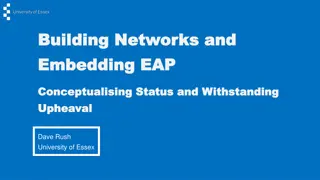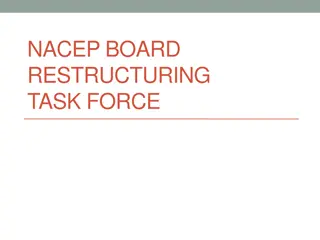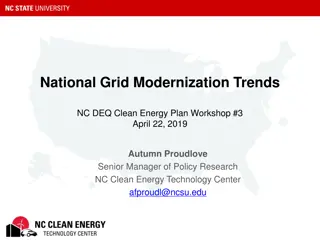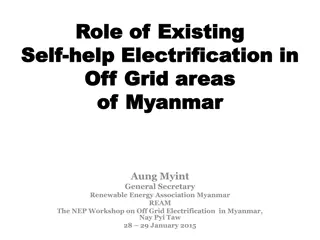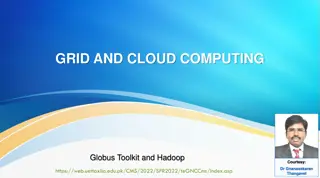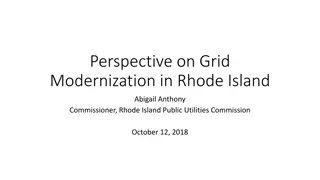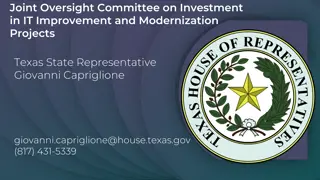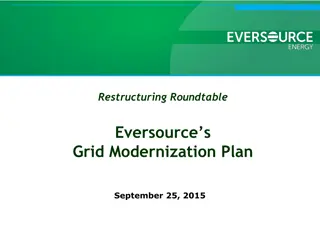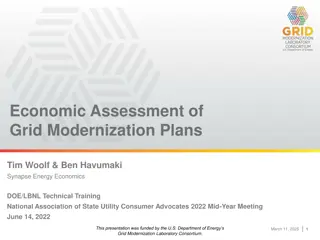Grid Modernization and Restructuring: Key Components and Objectives
In the realm of grid modernization and restructuring, there are essential components and objectives that focus on improving outage management, optimizing demand, integrating distributed resources, enhancing workforce and asset management, and more. The process also involves reviewing rate design, customer value focus, and understanding the impact of grid modernization costs on individual customers. With a comprehensive plan in place, utilities aim to enhance efficiency and reliability while transitioning towards a distributed energy future.
Download Presentation

Please find below an Image/Link to download the presentation.
The content on the website is provided AS IS for your information and personal use only. It may not be sold, licensed, or shared on other websites without obtaining consent from the author.If you encounter any issues during the download, it is possible that the publisher has removed the file from their server.
You are allowed to download the files provided on this website for personal or commercial use, subject to the condition that they are used lawfully. All files are the property of their respective owners.
The content on the website is provided AS IS for your information and personal use only. It may not be sold, licensed, or shared on other websites without obtaining consent from the author.
E N D
Presentation Transcript
MA Grid Modernization Restructuring Roundtable September 25, 2015
DPU Grid Modernization Order 10 Year GMPs updated every 5 years First filing due August 5th Comprehensive Grid Mod Plan Reduce the effect of outages Optimize demand, including reducing system and customer costs Integrate distributed resources Improve workforce and asset management DPU Objectives Timing and priority for all grid mod planning and investment over 10 years 5-year STIP which includes advanced metering functionality; must analyze STIP using business case cost-benefit model from DPU Marketing, education and outreach plan; statewide and company-specific Infrastructure and performance metrics (statewide and company-specific); RD&D; cybersecurity, privacy, and meter data access Stakeholder engagement required Plan Elements Tracker for incremental STIP CapEx; if Company is proposing to achieve AMF, then other incremental capital investments in the first 5 years can be included in CapEx tracker Cost Recovery 2
Overall GMP Approach What modernization approaches provide financial and qualitative value for customers? What investments should be the immediate focus? What is the value of the distribution utility in a distributed energy future? Reviewing rate design essential to understanding the effect of grid mod cost on individual customers 3
Core GMP Components Automated Metering Functionality (AMF) TVR compatible Smart Meters, Communications interfaces Head End / Meter Data management System (MDMS) / Outage Management System (OMS) Grid Field Devices: Advanced Distribution Automation (ADA) Volt VAR optimization / Conservation Voltage Reduction (VVO/CVR) Remote Feeder Sensors Customer Outreach, Education, Demand Response Customer Load Management devices and programs Marketing/Outreach/Education efforts 4
Core GMP Components Internal Infrastructure Investments: Field Communications Network (Supports AMI and Grid Devices) Data Storage and Service/ Cyber Security services Support Services (Call Center, Additional Staff) Advanced Distribution Management System (ADMS) and Distribution Supervisory Control And Data Acquisition (DSCADA) system 5
Funding Source Cat- egory Plan Component AMIFocused Option 2 Balanced Plan Option 1 100% Opt-out deployed in 5 Years 100% Opt-out deployed in 5 Years STIP Field Deploy- ment AMI Meters Customer Portal and DRMS, Devices through Energy Efficiency Programs Customer Portal and DRMS, Devices through Energy Efficiency Programs CLM Summary of GMP Scenarios (1) ADA / VVO to 30% of customers, Feeder sensors VVO to 15% of customers ADA, VVO, Feeder sensors Yes No Enabling Infra- structure ADMS/DSCADA To support AMI, and Grid investments To support AMI, and Grid investments Telecomm Incl. data lake, MDMS, Integration services, Integrated network Operations Center and Apps. Reduced IT/OT to support AMI data integration only IT/OT investments As necessary As necessary for reduced scope Cybersecurity and Billing Training and mobility services Training Only Workforce and Training Yes: Opt-Out Focused Yes: Opt-Out Focused Marketing, Outreach and Education Application Tools, Analytic investment, Proactive substation upgrades Application Tools, Analytic investment, Proactive substation upgrades DER Tariff / Inter- connection DER DER Joint projects with EPRI/CEATI, Pilots which include ES, microgrids, EV, etc Joint projects with EPRI/CEATI, Pilots which include ES, microgrids, EV, etc. RD&D Tracker RD&D RD&D Plan STIP Costs: US $830.5M US $657.1M .90 1.02 Benefit-Cost Ratio:
Funding Source Cat- egory Plan Component Grid Focused Option 3 Opt In AMI Option 4 30% Opt-out deployed in 10 Years, 70% Opt- in (cell) 100% Opt-In (cell) in full territory in 10 years STIP Field Deploy- ment AMI Meters Summary of GMP Scenarios (2) Customer Portal and DRMS, Devices through Energy Efficiency Programs Expansion of SES CLM ADA / VVO to 30% of customers, Feeder sensors ADA and VVO to 30% of customers, Feeder sensors ADA, VVO, Feeder sensors Yes Yes Enabling Infra- structure ADMS/DSCADA To support AMI, and Grid investments 30% territory Cell based AMI and Grid investments Telecomm Reduced IT/OT to support AMI data integration only Expansion of SES infrastructure IT/OT investments As necessary for reduced scope Expansion of SES Cybersecurity and Billing Training Only Training Only Workforce and Training Yes: Opt-in Focused Yes: Both Opt-Out and Opt-In Marketing, Outreach and Education Application Tools, Analytic investment, Proactive substation upgrades Application Tools, Analytic investment, Proactive substation upgrades DER Tariff / Inter- connection DER DER Joint projects with EPRI/CEATI, Pilots which include ES, microgrids, EV, etc. Joint projects with EPRI/CEATI, Pilots which include ES, microgrids, EV, etc. RD&D Tracker RD&D RD&D Plan STIP Costs: US $573.1 US $225.3M Benefit-Cost Ratio: .57 .54
GMP: RD&D Proposal Total Cost over 10 Yrs National Grid s RD&D Program will focus on the following areas: (1) Integration of Distributed Energy Resources (DER) (2) Alternative Fuel Vehicles (3) Cost Savings / Environmental Benefits (4) Workforce and Asset Management Savings Project 1. Analytics for Asset Management $ 400,000 2. Microgrid $ 5,000,000 3. Fault Location Analysis 4. Renewable-Integrated DES (Distribution Energy Storage) Demonstration $ 400,000 $ 7,077,500 5. Targeted inverter conversion $ 690,000 6. High Density CES $ 14,372,500 7. Short Term Renewable Forecasting $ 400,000 The cost of baseline projects that are part of collaborative efforts with the JU are not included in our proposal. 8. Sensor Development Program $ 280,000 9. DC to DC Charging $ 580,000 10. V2G Study and Demonstration $ 75,000 RD&D Total $29,275, 000
Grid Mod Plan: Cost Recovery Recovery of all incremental capital and O&M for Grid Mod including ongoing Run The Business costs Propose concurrent recovery and immediate recovery of previously incurred incremental costs to date Requesting 5 year recovery on RD&D capital projects 9
Grid Mod Plan: Time-Varying Rates Proposal follows Smart Energy Solutions pricing approach Variable Critical Peak Pricing Basic Service re-designed into CPP using ISO-NE energy prices and Forward Capacity Market value for generation Peak events with highest prices called max of 175 hours or 30 days with no more than 8 hours at a time Peak event prices can be 5 times the onpeak rate for other hours Investigating potential to have suppliers bid to provide this type of pricing structure 10
Rate Design Proposals Rate designs are proposed to move towards fair and equitable recovery of costs for a sustainable future grid Inclining customer/minimum charge for Residential and small commercial to reflect size of customer Limit impact to +/-5% on bills No change to G-2 and G-3 demand rates Stand-alone Distributed Generation tariff proposal Reflects fair allocation of costs based upon value from DG using grid for market access Distribution costs, not interconnection costs (Tracker issue) Long-term fold these customers into the rate class as appropriate and assess interconnection costs through Contribution In Aid of Construction policies. 11
Appendix 12
Development of GMP - Stakeholder Feedback The key themes that stakeholders focused on included: Keeping the environment at the forefront: However, customer research suggests otherwise Enabling third party participation through vendors and other partners by designing a modernized grid that allows third parties to interact with the utility and with customers Focus on the importance of marketing, outreach and education Leveraging energy efficiency programs to incorporate smart devices Providing customers with pricing signals Building trust by improving outage response and sharing accurate estimated times of restoration Developing demonstration projects and phasing deployment. 13
Development of GMP Pilot Lessons Learned In developing the GMP, the Company took into account relevant pilot lessons learned such as: Worcester Smart Energy Solutions: Vendor management RF/Cell Wireless Communications design is important Efficiency of Part Time resources vs. Full Time Strong Project Management Office necessary Importance of a strong Outreach and Education plan Criticality of Over the Air (OTA) software updates Rhode Island VVO/CVR Pilot: Integration of RF and grid design stages Phased design and deployment from inside out. 14
Grid Deployment Prioritization: Example District 15
Flexible GMP Components Research, Development and Demonstration (RD&D) Potential examples include Microgrids, Energy Storage, Next Generation technologies Joint Utility knowledge sharing mechanism Leverage work through other organizations such as EPRI and CEATI Separate tracker Distributed Generation Investments (DG) Proactive System upgrades to accommodate more DG Application Management Tools Advanced Analytics and Forecasting Capabilities Customer Portals and Outreach Not included in the STIP; will ask for rate changes that allow for recovery 16
